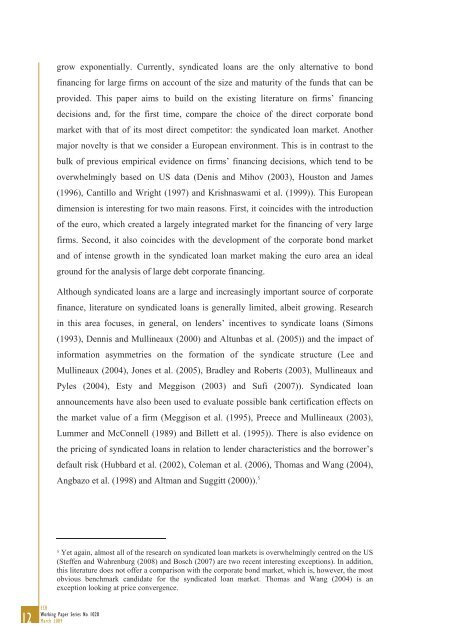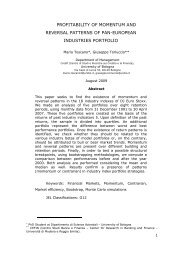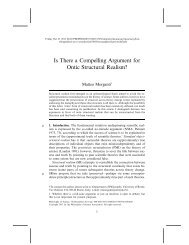large debt financing syndicated loans versus corporate bonds
large debt financing syndicated loans versus corporate bonds
large debt financing syndicated loans versus corporate bonds
You also want an ePaper? Increase the reach of your titles
YUMPU automatically turns print PDFs into web optimized ePapers that Google loves.
grow exponentially. Currently, <strong>syndicated</strong> <strong>loans</strong> are the only alternative to bond<br />
<strong>financing</strong> for <strong>large</strong> firms on account of the size and maturity of the funds that can be<br />
provided. This paper aims to build on the existing literature on firms’ <strong>financing</strong><br />
decisions and, for the first time, compare the choice of the direct <strong>corporate</strong> bond<br />
market with that of its most direct competitor: the <strong>syndicated</strong> loan market. Another<br />
major novelty is that we consider a European environment. This is in contrast to the<br />
bulk of previous empirical evidence on firms’ <strong>financing</strong> decisions, which tend to be<br />
overwhelmingly based on US data (Denis and Mihov (2003), Houston and James<br />
(1996), Cantillo and Wright (1997) and Krishnaswami et al. (1999)). This European<br />
dimension is interesting for two main reasons. First, it coincides with the introduction<br />
of the euro, which created a <strong>large</strong>ly integrated market for the <strong>financing</strong> of very <strong>large</strong><br />
firms. Second, it also coincides with the development of the <strong>corporate</strong> bond market<br />
and of intense growth in the <strong>syndicated</strong> loan market making the euro area an ideal<br />
ground for the analysis of <strong>large</strong> <strong>debt</strong> <strong>corporate</strong> <strong>financing</strong>.<br />
Although <strong>syndicated</strong> <strong>loans</strong> are a <strong>large</strong> and increasingly important source of <strong>corporate</strong><br />
finance, literature on <strong>syndicated</strong> <strong>loans</strong> is generally limited, albeit growing. Research<br />
in this area focuses, in general, on lenders’ incentives to syndicate <strong>loans</strong> (Simons<br />
(1993), Dennis and Mullineaux (2000) and Altunbas et al. (2005)) and the impact of<br />
information asymmetries on the formation of the syndicate structure (Lee and<br />
Mullineaux (2004), Jones et al. (2005), Bradley and Roberts (2003), Mullineaux and<br />
Pyles (2004), Esty and Meggison (2003) and Sufi (2007)). Syndicated loan<br />
announcements have also been used to evaluate possible bank certification effects on<br />
the market value of a firm (Meggison et al. (1995), Preece and Mullineaux (2003),<br />
Lummer and McConnell (1989) and Billett et al. (1995)). There is also evidence on<br />
the pricing of <strong>syndicated</strong> <strong>loans</strong> in relation to lender characteristics and the borrower’s<br />
default risk (Hubbard et al. (2002), Coleman et al. (2006), Thomas and Wang (2004),<br />
Angbazo et al. (1998) and Altman and Suggitt (2000)). 5<br />
5 Yet again, almost all of the research on <strong>syndicated</strong> loan markets is overwhelmingly centred on the US<br />
(Steffen and Wahrenburg (2008) and Bosch (2007) are two recent interesting exceptions). In addition,<br />
this literature does not offer a comparison with the <strong>corporate</strong> bond market, which is, however, the most<br />
obvious benchmark candidate for the <strong>syndicated</strong> loan market. Thomas and Wang (2004) is an<br />
exception looking at price convergence.<br />
12 ECB<br />
Working Paper Series No 1028<br />
March 2009

















